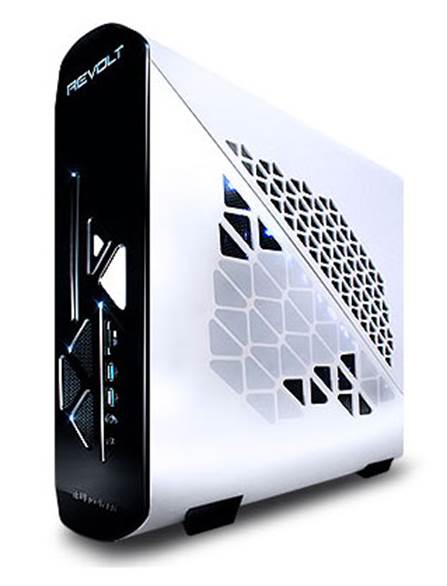To revolt is to rise up against an
oppressive ruling authority. In iBuypower’s case, is the new Revolt PC opposing
big gaming rigs or game consoles?
We prefer to believe that the Revolt, along
with its fellow revolutionaries from Alienware, Falcon Northwest, and Digital
Storm, is part of the first expeditionary force attacking the substandard
gaming performance that consoles have subjected its citizens to for years.
As we’ve said of the other small PCs of
this ilk, you need only slap a $26 wireless Xbox controller on the Revolt, get
it set up with Steam’s Big Picture Mode, and you’ll not only have a gaming
machine that fits in nicely in the living room, but that will also likely blow
away even next-gen consoles.

iBuypower
Revolt
The Revolt uses a new NZXT chassis that
iBuypower has exclusive rights to. It’s slightly wider than three other
similarly shaped boxes we’ve reviewed from Alienware, Falcon Northwest, and
Digital Storm. iBuypower manages to jam in a 14cm NZXT liquid cooler, which
lets the Intel Core i7-3770K hum along at an overclocked 4.2GHz. The rig also
sports an EVGA GeForce GTX 670 GPU and is large enough to support both an HDD
and SSD. This is significant because the box that spurred it all, Alienware’s
X51, forces you to pick either an HDD or SSD, not both.
While the X51 uses an external power brick,
the iBuypower uses an internal FSP 500-watt PSU. There's actually an upside and
downside to both setups. The downside here is the noise. Our pre-production
Revolt’s 1U power supply got shrilly under heavy loads. We had the same issue
with Digital Storm’s Bolt, which was rectified in shipping units. iBuypower
promises improvement in the final units, but ours was just too noisy to be used
under load in an HTPC environment. However, seeing how other vendors have been
able to tame the issue by tweaking the fan profiles and thermals, we suspect
iBuypower will be able to do the same.
Performance of the box against our desktop
zero-point, with its hexa-core processor, was not pretty but that’s hardly a
surprise, considering the ZP’s size and parts. Lest you think that a quad-core
Ivy Bridge ticking at 4.2GHz is Atom-poo slow, however—it’s not. Even in the
heavily multithreaded Premiere Pro test, the Ivy Bridge was but 31 percent
slower than our Core i7-3930K at 3.8GHz. The GeForce GTX 570 also shows pretty
well when you consider that the zero-point is housing a GeForce GTX 690.

Overall,
iBuypower gets a lot right with the Revolt and brings its trademark practice of
packing in the performance without packing on the price
We also stacked up the Revolt against the
Falcon Northwest Tiki and Digital Storm Bolt (we didn’t have the original X51
on which to run our new benchmarks) and found the Revolt competitive but the
slow man out against its two peers. Oddly enough, in our Premiere Pro CS6
benchmark, the similarly clocked Revolt ran about 9 percent behind the Tiki and
11 percent behind the Bolt - that’s probably partly due to its single-channel
RAM.
But there are a couple of ways in which the
Revolt excels over those two boxes. For one thing, it has the ability to run
when laid flat, which makes it far more flexible for living room use. It also
beats both the Tiki and Bolt in the price game. The FNW Tiki we reviewed in
September 2012 came equipped with dual 500GB SSDs and a GeForce GTX 680 for
$4,126. No doubt 500GB SSDs have dropped in price, but not by that much. The
Digital Storm Bolt, reviewed in our January 2013 issue, took the
price down to $1,950, using just a 120GB SSD but giving you a GTX 680 card,
too. The iBuypower Revolt comes in even lower, at $1,400. Is that a good deal?
Spec-for-spec, yes. It’s even comparable to Alienware’s top-end X51, which gives
you a 2TB HDD and 16GB of RAM, but is capped at a GeForce GTX 660 and there’s
no option for an SSD.

That puts the Revolt in a pretty good spot.
No, you can’t get it as spec’d-out as the Bolt or Tiki, but at this price, a
lot of folks won’t care. Overall, iBuypower gets a lot right with the Revolt
and brings its trademark practice of packing in the performance without packing
on the price.
|
Specifications
§ Processor:
Intel Core i7-3770K04.2GHz
§ Mobo:
iBuypower Z77E
§ RAM:
8GB DDR3/1600 single-channel
§ Video
Card: EVGA GeForce GTX 670
§ Sound
Card: Onboard
§ Storage:
120GB Intel 330 Series SSD, 1TB WD Caviar Blue
§ Optical:
Blu-ray combo drive WHUN5-40
§ Case/PSU:
Custom / FSP 500W
|